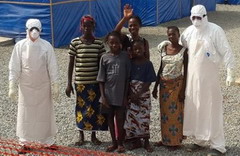Durante el brote de la enfermedad del virus del Ébola (EVD) de 2014-2016 en África occidental, los profesionales enfrentaron desafíos para brindar atención nutricional a los pacientes en las unidades de tratamiento del Ébola (ETU). El brote actual de EVD en la República Democrática del Congo demuestra la necesidad de comprender las lecciones aprendidas de brotes anteriores y actualizar las pautas nutricionales. Read more on Atención nutricional para pacientes con enfermedad por el virus del Ébola…
Filed under Apoyo bibliográfico by on feb 15th, 2020. Comment. ![]()
 Sequencing of Ebola virus (EBOV) genomes during the 2014-2016 epidemic identified several naturally occurring, dominant mutations potentially impacting virulence or tropism. In this study, we characterized EBOV variants carrying one of the following substitutions: A82V in the glycoprotein (GP), R111C in the nucleoprotein (NP), or D759G in the RNA-dependent RNA polymerase (L). Compared with the wild-type (WT) EBOV C07 isolate, NP and L mutants conferred a replication advantage in monkey Vero E6, human A549, and insectivorous bat Tb1.Lu cells, while L mutants displayed a disadvantage in human Huh7 cells. Read more on Naturally Occurring Single Mutations in Ebola Virus Observably Impact Infectivity…
Sequencing of Ebola virus (EBOV) genomes during the 2014-2016 epidemic identified several naturally occurring, dominant mutations potentially impacting virulence or tropism. In this study, we characterized EBOV variants carrying one of the following substitutions: A82V in the glycoprotein (GP), R111C in the nucleoprotein (NP), or D759G in the RNA-dependent RNA polymerase (L). Compared with the wild-type (WT) EBOV C07 isolate, NP and L mutants conferred a replication advantage in monkey Vero E6, human A549, and insectivorous bat Tb1.Lu cells, while L mutants displayed a disadvantage in human Huh7 cells. Read more on Naturally Occurring Single Mutations in Ebola Virus Observably Impact Infectivity…
Filed under Apoyo bibliográfico by on may 20th, 2019. Comment. ![]()
 Ebola virus (EBOV) can persist in immunologically protected body sites in survivors of Ebola virus disease, creating the potential to initiate new chains of transmission. From the outbreak in West Africa during 2014–2016, we identified 13 possible events of viral persistence–derived transmission of EBOV (VPDTe) and applied predefined criteria to classify transmission events based on the strength of evidence for VPDTe and source and route of transmission. Read more on Ebola Virus Infection Associated with Transmission from Survivors…
Ebola virus (EBOV) can persist in immunologically protected body sites in survivors of Ebola virus disease, creating the potential to initiate new chains of transmission. From the outbreak in West Africa during 2014–2016, we identified 13 possible events of viral persistence–derived transmission of EBOV (VPDTe) and applied predefined criteria to classify transmission events based on the strength of evidence for VPDTe and source and route of transmission. Read more on Ebola Virus Infection Associated with Transmission from Survivors…
Filed under Apoyo bibliográfico by on abr 15th, 2019. Comment. ![]()
BACKGROUND:
While a number of predictors for Ebola mortality have been identified, less is known about post-viral symptoms. The identification of acute-illness predictors for post-viral symptoms could allow the selection of patients for more active follow up in the future, and those in whom early interventions may be beneficial in the long term. Studying predictors of both mortality and post-viral symptoms within a single cohort of patients could also further our understanding of the pathophysiology of survivor sequelae. Read more on Surviving Ebola: A historical cohort study of Ebola mortality and survival in Sierra Leone 2014-2015….
Filed under Apoyo bibliográfico by on mar 15th, 2019. Comment. ![]()
Since 1976, in more than 40 recorded outbreaks to date, Ebola virus disease (EVD) has dramatically affected the human population across the Central African region and adjacent areas. The large West African outbreak (2013–2015) was a game changer in many aspects, not only with regard to geographical location and the number of patients and deaths, but also in terms of the international community’s response it finally triggered; albeit belatedly so. The progress made in our epidemiological and clinical understanding of the disease was immense, as well as advances in the development of an effective vaccine (e.g. rVZV-ZEBOV), specific therapeutic options (e.g. monoclonal antibodies, convalescent whole blood), and candidates for post-exposure prophylaxis (e.g. Favipiravir) [ ]. Read more on Ebola 2018 – Implications for travel health advice and relevance for travel medicine…
Filed under Apoyo bibliográfico by on feb 3rd, 2019. Comment. ![]()


